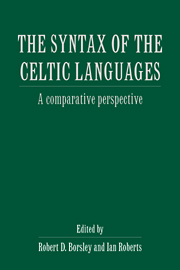Book contents
- Frontmatter
- Contents
- List of contributors
- Introduction
- 1 Long head movement in Breton
- 2 Some syntactic effects of suppletion in the Celtic copulas
- 3 Fronting constructions in Welsh
- 4 Bod in the present tense and in other tenses
- 5 Pronominal enclisis in VSO languages
- 6 Aspect, agreement and measure phrases in Scottish Gaelic
- 7 A minimalist approach to some problems of Irish word order
- 8 Subjects and subject positions in Irish
- 9 Negation in Irish and the representation of monotone decreasing quantifiers
- 10 On structural invariance and lexical diversity in VSO languages: arguments from Irish noun phrases
- References
- Index
2 - Some syntactic effects of suppletion in the Celtic copulas
Published online by Cambridge University Press: 18 December 2009
- Frontmatter
- Contents
- List of contributors
- Introduction
- 1 Long head movement in Breton
- 2 Some syntactic effects of suppletion in the Celtic copulas
- 3 Fronting constructions in Welsh
- 4 Bod in the present tense and in other tenses
- 5 Pronominal enclisis in VSO languages
- 6 Aspect, agreement and measure phrases in Scottish Gaelic
- 7 A minimalist approach to some problems of Irish word order
- 8 Subjects and subject positions in Irish
- 9 Negation in Irish and the representation of monotone decreasing quantifiers
- 10 On structural invariance and lexical diversity in VSO languages: arguments from Irish noun phrases
- References
- Index
Summary
Introduction
This study addresses broadly the issue of how syntax and morphology interact. I approach this topic by examining some of the syntactic consequences of irregular forms that appear in the third-person present tense of the copula in many of the Celtic languages. I suggest in section 2 that the Welsh and Breton copulas are fundamentally different and reproduce a distinction familiar from traditional descriptions of Irish: the Welsh copula is a substantive (i.e. lexical) copula while its Breton counterpart is a functional (or ‘grammatical’) copula, a spellout of tense and agreement features. I then argue in section 3 that, although both languages exhibit irregular forms in the copula's third-person present tense, they behave quite differently syntactically, and that this fact correlates with the distinction between substantive and functional copulas. Only the (Welsh) substantive copula exhibits suppletion that has syntactic effects; the (Breton) functional copula varies morphophonemically in terms of its spell-out and is syntactically inert. I make use of ideas of Pesetsky (1994) to model variation in the morphosyntactic restrictions of the Welsh substantive copula. Both the substantive and functional copula are, I claim, similar in terms of their selectional properties. Their difference, like other kinds of ‘syntactic’ variation between languages, is a formal, morphosyntactic one. In essence my claim is that the variation in the copulas reduces to a formal one between lexical formatives and functional formatives.
- Type
- Chapter
- Information
- The Syntax of the Celtic LanguagesA Comparative Perspective, pp. 75 - 96Publisher: Cambridge University PressPrint publication year: 1996
- 4
- Cited by

